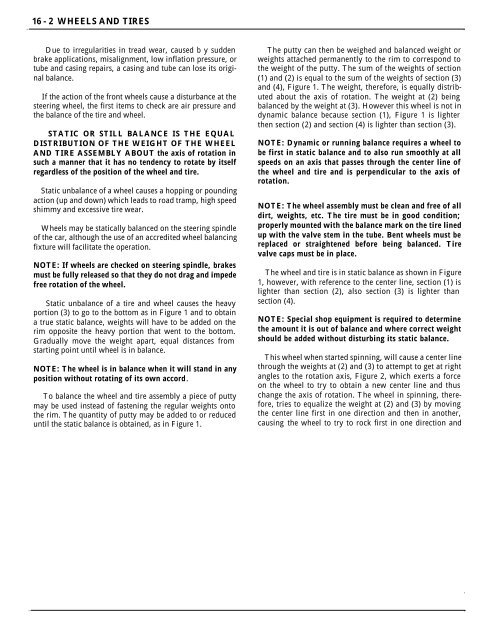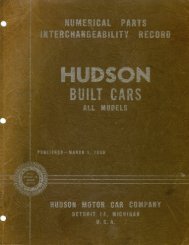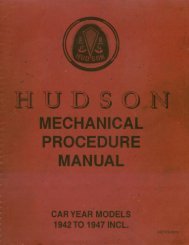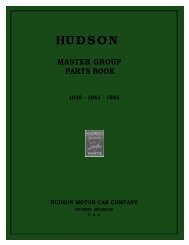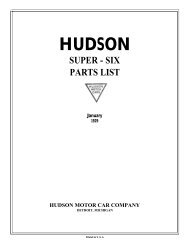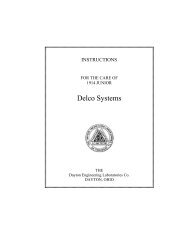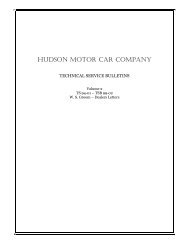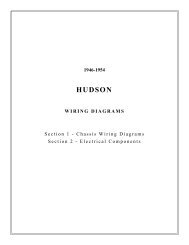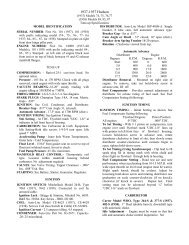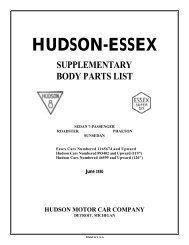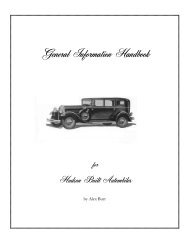1948-1952 Shop Service Manual - - Hudson-Essex-Terraplane Club
1948-1952 Shop Service Manual - - Hudson-Essex-Terraplane Club
1948-1952 Shop Service Manual - - Hudson-Essex-Terraplane Club
You also want an ePaper? Increase the reach of your titles
YUMPU automatically turns print PDFs into web optimized ePapers that Google loves.
16 - 2 WHEELS AND TIRES<br />
Due to irregularities in tread wear, caused b y sudden<br />
brake applications, misalignment, low inflation pressure, or<br />
tube and casing repairs, a casing and tube can lose its original<br />
balance.<br />
If the action of the front wheels cause a disturbance at the<br />
steering wheel, the first items to check are air pressure and<br />
the balance of the tire and wheel.<br />
STATIC OR STILL BALANCE IS THE EQUAL<br />
DISTRIBUTION OF THE WEIGHT OF THE WHEEL<br />
AND TIRE ASSEMBLY ABOUT the axis of rotation in<br />
such a manner that it has no tendency to rotate by itself<br />
regardless of the position of the wheel and tire.<br />
Static unbalance of a wheel causes a hopping or pounding<br />
action (up and down) which leads to road tramp, high speed<br />
shimmy and excessive tire wear.<br />
Wheels may be statically balanced on the steering spindle<br />
of the car, although the use of an accredited wheel balancing<br />
fixture will facilitate the operation.<br />
NOTE: If wheels are checked on steering spindle, brakes<br />
must be fully released so that they do not drag and impede<br />
free rotation of the wheel.<br />
Static unbalance of a tire and wheel causes the heavy<br />
portion (3) to go to the bottom as in Figure 1 and to obtain<br />
a true static balance, weights will have to be added on the<br />
rim opposite the heavy portion that went to the bottom.<br />
Gradually move the weight apart, equal distances from<br />
starting point until wheel is in balance.<br />
NOTE: The wheel is in balance when it will stand in any<br />
position without rotating of its own accord.<br />
To balance the wheel and tire assembly a piece of putty<br />
may be used instead of fastening the regular weights onto<br />
the rim. The quantity of putty may be added to or reduced<br />
until the static balance is obtained, as in Figure 1.<br />
The putty can then be weighed and balanced weight or<br />
weights attached permanently to the rim to correspond to<br />
the weight of the putty. The sum of the weights of section<br />
(1) and (2) is equal to the sum of the weights of section (3)<br />
and (4), Figure 1. The weight, therefore, is equally distributed<br />
about the axis of rotation. The weight at (2) being<br />
balanced by the weight at (3). However this wheel is not in<br />
dynamic balance because section (1), Figure 1 is lighter<br />
then section (2) and section (4) is lighter than section (3).<br />
NOTE: Dynamic or running balance requires a wheel to<br />
be first in static balance and to also run smoothly at all<br />
speeds on an axis that passes through the center line of<br />
the wheel and tire and is perpendicular to the axis of<br />
rotation.<br />
NOTE: The wheel assembly must be clean and free of all<br />
dirt, weights, etc. The tire must be in good condition;<br />
properly mounted with the balance mark on the tire lined<br />
up with the valve stem in the tube. Bent wheels must be<br />
replaced or straightened before being balanced. Tire<br />
valve caps must be in place.<br />
The wheel and tire is in static balance as shown in Figure<br />
1, however, with reference to the center line, section (1) is<br />
lighter than section (2), also section (3) is lighter than<br />
section (4).<br />
NOTE: Special shop equipment is required to determine<br />
the amount it is out of balance and where correct weight<br />
should be added without disturbing its static balance.<br />
This wheel when started spinning, will cause a center line<br />
through the weights at (2) and (3) to attempt to get at right<br />
angles to the rotation axis, Figure 2, which exerts a force<br />
on the wheel to try to obtain a new center line and thus<br />
change the axis of rotation. The wheel in spinning, therefore,<br />
tries to equalize the weight at (2) and (3) by moving<br />
the center line first in one direction and then in another,<br />
causing the wheel to try to rock first in one direction and<br />
heel


